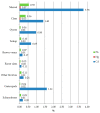Heavy Metals Contamination in Shellfish: Benefit-Risk Evaluation in Central Italy
- PMID: 33238443
- PMCID: PMC7700650
- DOI: 10.3390/foods9111720
Heavy Metals Contamination in Shellfish: Benefit-Risk Evaluation in Central Italy
Abstract
Seafood is a source of nutrients in human diet but also of environmental contaminants and its consumption could pose a risk to consumers' health. A survey regarding the exposure to cadmium, lead and mercury through the consumption of bivalve mollusks, gastropods and sea urchins collected on Italian coasts was carried out among central Italian population over a period of three years. A limited number of samples exceeds the threshold set by legislation (6 samples) and the average level of contamination was low in all the species considered. The contribution Acceptable Daily Intake (ADI) was higher for cadmium (9.17%) than lead (1.44%) and mercury (0.20%). The benefit-risk evaluation suggests that the bivalve mollusks and sea urchins consumption (Benefit Risk Quotient < 1) could be increased without health detrimental effects.
Keywords: cadmium; dietary exposure; dietary intake; gastropods; lead; mercury; sea urchins; shellfish.
Conflict of interest statement
The authors declare no conflict of interest.
Figures
References
-
- Gall J.E., Boyd R.S., Rajakaruna N. Transfer of heavy metals through terrestrial food webs: A review. Environ. Monit. Assess. 2015;187:201. - PubMed
-
- European Food Safety Agency Cadmium dietary exposure in the European population. EFSA J. 2012;10:2551.
-
- European Food Safety Agency Lead dietary exposure in the European population. EFSA J. 2012;10:2831.
-
- European Food Safety Agency Scientific opinion on the risk for public health related to the presence of mercury and methylmercury in food. EFSA J. 2012;10:2985.
-
- Kumar S., Sharma A. Cadmium toxicity: Effects on human reproduction and fertility. Rev. Environ. Health. 2015;34:327–338. - PubMed
LinkOut - more resources
Full Text Sources
Miscellaneous





